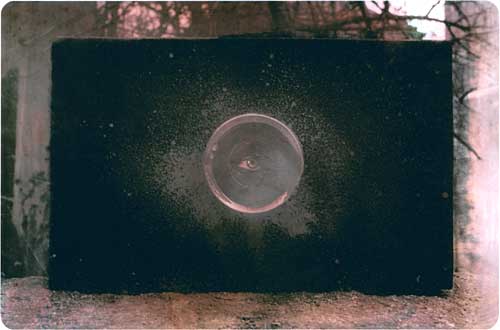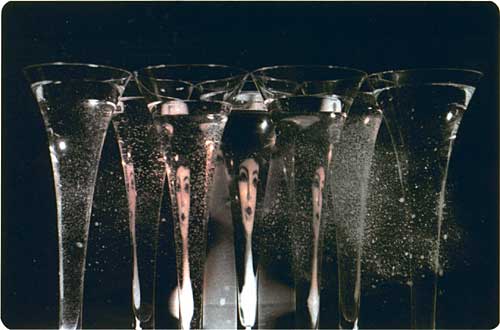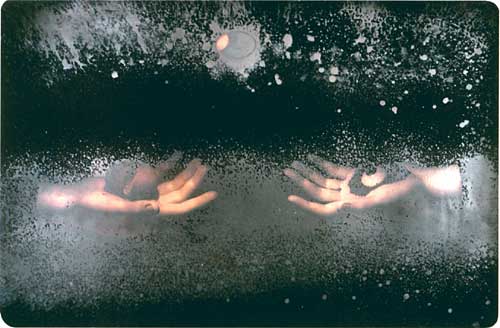




" Tym, co zaskakuje i podnieca, to fotografie,
które przemawiają do nas w nowy sposób nie dlatego,
że chcą być odmienne, ale dlatego,
że jednostka jest inna
i właśnie ta jednostka wyraża samą siebie."
Harry CallahanFotografia będąc świadkiem, środkiem przekazu i sposobem powszechnego komunikowania sprawia, że świat, który znamy jest światem z fotografii, jest rzeczywistością, której znajomość nie wynika z autopsji i bezpośredniego z nią kontaktu. Układ sieciowy informacji wizualnej sprawił, że fotografia i obraz fotograficzny stały się niezwykle pojemnym, wdzięcznym i wszechobecnym medium, w którym relacje obiekt-obraz i obraz-odbiorca stały się podstawowymi elementami owej sieci. Wszechpanująca tendencja totalnej rejestracji widzialnego (wszystkiego) sprawiła, że nastąpiła nadprodukcja obrazów, ich wartość stała się powierzchowna i banalna, wyliczona na dzisiejsze krótkotrwałe potrzeby. Relacja obraz-odbiorca a obiekt-obraz już nie zawsze są tożsame, zacierają się często, a prawda i fikcja stają się pojęciami względnymi, stają się elementami gry i polem interpretacji. Nałożone modele i siatki kulturowe, historyczne, społeczne, poznawcze, intelektualne, pojęciowe powodują, że chociaż użyte medium przywołuje poczucie prawdziwości i autentyczności, to w rezultacie jest nadmiarem obrazów i informacji o teraźniejszości i przeszłości prawdziwych, a jednocześnie nieprecyzyjnych i uogólnionych, dających pole do szukania fikcji i mitów poprzez świadectwo realności. Kreacyjność fotografii Patrycji Orzechowskiej to gra widzialnego z niewidzialnym, w której z góry ustalona została zasada nieautentyczności, pozoru, fikcji. Rejestracja fotograficzna połączona z zapisem manualnym i związana ideą plakatu, opracowania graficznego czy koncepcją zdjęcia jako obrazu autonomicznego daje utwór o rodowodzie medialnym. Dążenie do wyrażania głębi, tajemnicy, niedomówień, zmysłowości, ponadrealności są (lub zdają się być) szczególnym celem wypowiedzi Patrycji. "Postarzanie" fotografii, nawiązywanie do jej archaicznego okresu, wykorzystywanie pozorów błędu technologicznego, specyficzna inscenizacja czy aranżacja są jej ulubionymi, własnymi środkami wypowiedzi. Obrazy, które tworzy są jakby z pogranicza obrazu graficznego i fotografii, rysunku i fotografii dokumentalnej, teatru i prawdy. Ciekawy jest ten świat, wartościowy i niepowtarzalny, świat rzeczy błahych i ważnych, prawdy i fikcji, realności i nadrealności, zadumy i wrażliwości, fascynacji i wątpliwości. Nakładanie doświadczeń, przenikanie stylistyk tworzą dokument o niej samej, komunikat wyrażony przy pomocy fikcji, sygnalizujący osobowość artystki, dokument unaocznionej wyobraźni, obraz prawdy poprzez fikcję służący do swobodnego i dowolnego interpretowania.
Witold Węgrzyn
Gdańsk, październik 2000
Foto © Patrycja Orzechowska: Metropolis Fritz Lang (1926)
Foto © Patrycja Orzechowska: Zmęczona śmierć Fritz Lang (1921)
What surprises and excites us is photographs
which speak to us in a new way not because
they want to be different but
because each individual is different
and it is exactly this individual
that expresses himself
Harry CallahanPhotography being a witness, a medium of information and a means of universal communication transforms the world we know into the world of photography, into reality the knowledge of which is not a result of our direct experience and direct contact with it. The network system of visual information caused photography and the photographic image to be an extraordinarily spacious, graceful and ubiquitous medium in which the relations of object/image and of image/receiver have become the basic elements of this network system. The overwhelming tendency of total registration of all things visible caused an overproduction of images whose value has become superficial, banal and calculated only with regard to the short-lived demands of the present day. The relations between an object and the image and between an image and the receiver are not identical any more, as they are often blurred, while truth and fiction become relative concepts, elements of play and fields of interpretation. Various models and cultural, historical, social, cognitive, intellectual and conceptual nets imposed on us are the reason why although the medium employed in the given instance recalls the feeling of truth and authenticity, it itself is the surplus of truthful images and pieces of information about the present and the past, which at the same time are generalized and far from precise - giving us the space for the search of fictions and myths through the evidence of reality. Creativity of photographs by Patrycja Orzechowska is the play of the visible with the invisible where the rule of inauthenticity, illusion and fiction had been established beforehand. Photographic registration together with manual recording, bound by an idea of a poster, some graphic work or the concept of a photograph as an autonomous image results in the creation of a piece of media origin. The attempt to express depth, mystery, implicitness, sensuality and surreality are (or seem to be) the most particular goals of Patrycja's work. The "aging" of photographs and reference to its archaic period, the use of seeming technological errors, the specific staging of the set or its arrangement are Patrycja's own favourite means of expression. The images she creates seem to be a combination of graphic works and photography, drawings and documentary photography, theatre and truth. It is an interesting world, valuable and unique, the world of trifle and important things, truth and fiction, reality and surreality, reflection and sensitivity, fascination and doubt. The overlapping of experiences and the permeation of styles make up a document about her, a message expressed by means of fiction signalling the personality of the artist, a document of imagination visualized. It is an image of truth through fiction - subject to free and uninhibited interpretation.
Witold Węgrzyn
Gdańsk, october 2000
translated by Maciej Świerkocki
Copyright ©2000 Galeria FF ŁDK, Patrycja Orzechowska, Witold Węgrzyn.